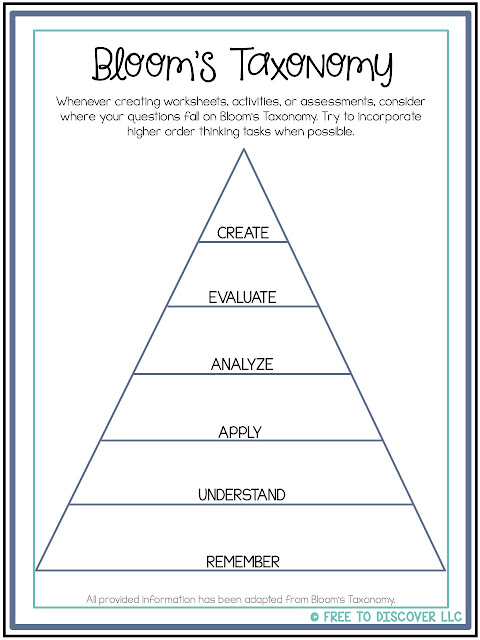
Using Bloom to Help Learning Boom
I reference Bloom's Taxonomy almost every day, and if you are also a math teacher, here's why you should, too. Bloom's Taxonomy helps teachers:
- Easily differentiate instruction using specific key words and tasks.
- Engage students in higher order thinking.
- Develop in students a deeper knowledge of the content.
- Facilitate outside-the-box experiences.
Okay, let's back up.
What is Bloom's Taxonomy?
Bloom's Taxonomy is a six-level hierarchy of questioning. According to Bloom, "Education must be increasingly concerned about the fullest development of all children and youth, and it will be the responsibility of schools to seek learning conditions which will enable each individual to reach the highest level of learning possible." Bloom strives to teach educators that we must increase expectations for our students by providing them with a path to higher order thinking; thereby, giving them opportunities to understand the nuanced nature of solutions to the world's problems. He says, "...a student attains 'higher order thinking' when he no longer believes in right or wrong."
As a math educator, does that leave you scratching your head? I get it. We spend a lot - maybe too much - time providing students opportunities to search for answers using algorithms. Though that is a large part of mathematics, there is so much more involved in making math REAL for the real experiences students will pursue. Let's dig into what this looks like in a middle school or high school math classroom.

Examples of Bloom's Taxonomy in Math Class
Bloom's Taxonomy consists of six levels. As you work your way up the pyramid, the levels increase. The first three levels represent average types of questioning. The top three levels represent higher order thinking questioning. To demonstrate the progression, read the sample tasks outlined below.
Level 1: REMEMBER
- Solve the equation.
- Graph the function.
- Complete the table.
- Calculate the sum.
Level 2: UNDERSTAND
- Show how you know.
- Explain your thinking.
- Give an example.
- Estimate the total.
Level 3: APPLY
- Write an equation to model the scenario.
- Solve the word problem.
- Demonstrate the theorem.
- Interpret the scatter plot.
Level 4: ANALYZE
- Compare and contrast the two strategies.
- Categorize the polygons.
- Classify the real numbers.
- Deduce the big idea.
Level 5: EVALUATE
- Make a conjecture.
- Identify the error.
- Correct the mistake.
- Prove the quadrilateral is a rectangle.
Level 6: CREATE
- Make an equation with the given parameters.
- Design a prism with a set volume.
- Devise a plan to show something is true.
- Build a model.
Want to put Bloom's Taxonomy into action? Download this free set of task cards.
Did you know...? When you join the Free to Discover community ($0), you'll access Issue 1 of a monthly newsletter for secondary math packed with higher order thinking questions? So what are you waiting for?? Sign up below!

Join the Free to Discover community!
When you subscribe, you'll access Issue 1 of our monthly newsletter for secondary math students!


